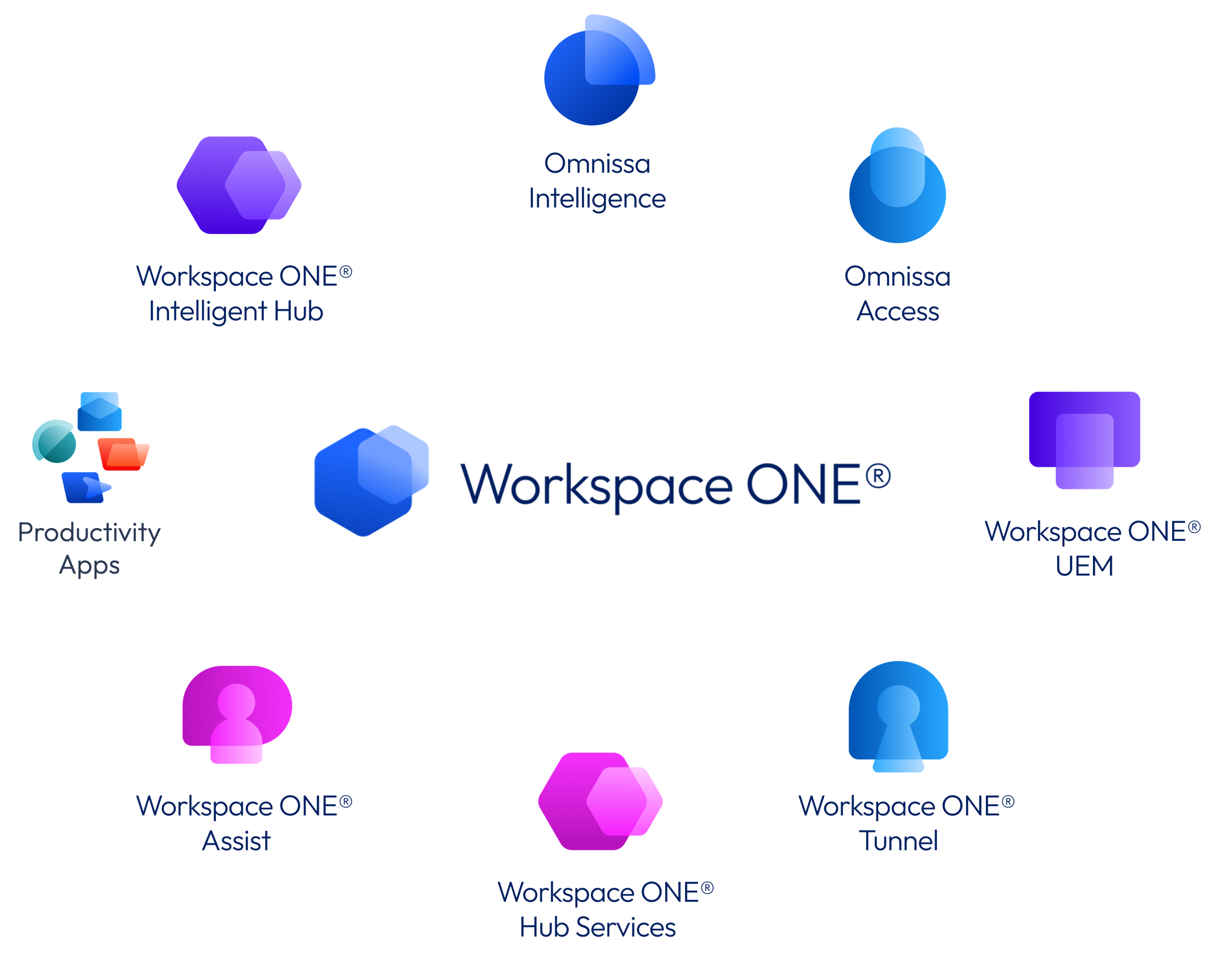Why so many Workspace ONEs and how are they different?

Can you tell the difference between Workspace ONE UEM, Workspace ONE Intelligent Hub, Workspace ONE Assist and Workspace ONE Productivity Apps? (And that’s not all – there are more!)
If you have a hard time telling them apart, you’re not alone. So, in this blog post, I’m going to briefly define and differentiate the variety of products and components that make up the Workspace ONE family and provide resources to learn more.
First, I’ll start with this diagram, which gives you an eagle’s eye view of the Workspace ONE family and how the different products and components relate to each other:

Next, I’ll briefly define each component and describe the role it plays in the big picture.

This is the overarching product family that delivers and manages any app on any device, provides secure access to corporate resources and optimizes digital employee experience. Workspace ONE integrates access control, application management, unified endpoint management and analytics. This enables your IT administrators to deliver a digital workspace that includes the devices and apps of choice, without sacrificing security and control.
Your end users might be anywhere—at a desk, on a train, in a kiosk, in the field. And they might be using any device—desktops, tablets, smartphones, wearables. To all the above, Workspace ONE delivers a modern digital workspace that provides them with the tools they need when, and where, they need them.
Like families do, the products and components that make up the Workspace ONE platform also bear the Workspace ONE name. I’ll describe them below. But first, want to know more about the overarching Workspace ONE family? If so, I recommend these:

Workspace ONE Unified Endpoint Management (UEM) is one of the main members of the Workspace ONE family—it’s the software that manages device lifecycle and secures corporate data on devices. Workspace ONE UEM, formerly known as AirWatch, was originally a mobile device management (MDM) vendor that started out managing rugged devices back before iOS released enterprise integrations (aka MDM Support). This is when MDM was truly born.
At first, MDM was busy managing mobile devices, and then Enterprise Mobility Management (EMM) brought things like mobile application, content, and email management into the mix. Then desktops moved from Product Cost and Lifecycle Management (PCLM) tools to EMM, which then gave birth to UEM. Today, your endpoint management is unified with every type of device you can imagine: desktops, mobile devices, rugged devices, head-mounted wearables, mobile printers and sleds, Linux devices, Internet of Things (IoT), and more.
Your users might be working in the field, on the front line, in the hospital. They all need the same secure, consistent, and reliable experience that office workers enjoy—and Workspace UEM provides that.
Want to learn more about Workspace ONE UEM? Check out these resources:
- What is Workspace ONE UEM?
- Workspace ONE UEM Technical Product Page
- Workspace ONE UEM Architecture
- Workspace ONE UEM Configuration

Omnissa Access is another key component when delivering a secure digital workspace to employees. Access provides authentication, access to SaaS apps and Horizon virtual apps and desktops, single sign-on to apps, multi-factor authentication, conditional access based on device posture, and more.
When you or your end users first log in, Omnissa Access checks your identification, and notes what permissions you have. Depending on who you are, it welcomes you with your personalized catalog displaying all the apps and virtual desktops that you are authorized to use, from native applications all the way to SaaS-based applications. If someone is not qualified to enter, it prevents them from going any further. Plus, no need to log in separately to each application because Omnissa Access applies single sign-on (SSO), which means that end users need to log in only once for access to all the apps and desktops that they are entitled to.
Want to learn more about Omnissa Access? Check out these resources:
- Omnissa Access Technical Product Page
- Omnissa Access Architecture
- Omnissa Access Documentation
- Installing the Omnissa Access Connector

Omnissa Intelligence is a cloud-only analytics platform that offers analysis and insight into security vulnerabilities, end-user experience and other issues among the devices and apps you’re managing and delivering to your end users. Intelligence is used for data aggregation and analysis across the entire Workspace ONE and Horizon deployments to improve digital employee experience, reduce security risk and automate and optimize IT operations.
The Omnissa Intelligence service correlates data from multiple sources which provides you with complete visibility into your environment. It provides both insights and data you need to make the best decisions for your deployment and users. It includes an automation engine which you can set to take automatic action on security or usability issues, based on rules and policies.
If you’d like to learn more about Omnissa Intelligence, check out these resources:
- What is Omnissa Intelligence?
- Getting Started with Omnissa Intelligence
- Omnissa Intelligence Architecture
- Vulnerability Management and Remediation with Omnissa Intelligence
- Intelligence for Horizon
- Omnissa Intelligence Documentation

Workspace ONE Intelligent Hub is the application that sits on each endpoint device like a client. Workspace ONE Intelligent Hub serves as a launching-pad that makes login easy for end users, and especially helpful for those with bring your own (BYO) devices.
With that first click, employees get Single Sign-On (SSO) for the ultimate ease of use. Once logged in, they launch any app from the catalog without needing to log in again separately. And they get all the Intelligent Hub capabilities, such as personalized corporate communications, team directory, and even self-service support tools—plus the handy corporate unified app catalog.
The company intranet portal can be embedded within the Intelligent Hub, and the Hub also provides easy access to native, web, and virtual apps and desktops with single sign-on and the best native experience for each device platform.
For more on the Intelligent Hub app, see:
- What is Workspace ONE Intelligent Hub?
- Workspace ONE Intelligent Hub App Documentation
- Moving to the Workspace ONE Intelligent Hub App Catalog
- Intelligent Hub Device & Quick Actions Feature Walkthrough

Workspace ONE Hub Services is a set of services that provide end users with an easy way to discover, access, and connect to your company’s resources, teams, and tools. End users have two options: they can access the configured Hub Services via Workspace ONE Intelligent Hub native app, or via a web browser. You can think of Hub Services as the server-side component, and the Intelligent Hub as the device-side client. Hub Services include:
- Unified App Catalog, which displays mobile and desktop apps, web or SaaS apps, and virtualized apps and desktops in an intuitive UI
- Corporate communications and notifications
- People Search, through which users can find colleagues and browse the company directory
 Self-service support resources and tools
Self-service support resources and tools - All with customizable branding
To learn more about Workspace ONE Hub Services, see this documentation.

Workspace ONE Assist is a specialized software component of Workspace ONE, developed to assist end users with issues that come up during remote working, use of tools, onboarding and so on. Workspace ONE Assist allows you to remotely access and troubleshoot devices in real time while respecting end-user privacy. End users can accept, pause, and end a remote session at any time for privacy reasons.
The Workspace ONE Assist client provides a combination of remote control and other support tools, plus device information, which enables you to troubleshoot issues on devices quickly and accurately. To learn more:
- Workspace ONE Assist Architecture
- Workspace ONE Assist Configuration
- Workspace ONE Assist Documentation

Workspace ONE Tunnel is the client app that securely connects your end users to the applications and desktops they want
to access. The connection is formed through the Tunnel Gateway on the back end. The Tunnel Gateway has several deployment options detailed in documentation here.
The Workspace ONE Tunnel enables secure access for mobile workers and their devices. The result is that end users enjoy a smooth and consistent experience and do not need to interact with the back end. IT organizations can take a least-privileged approach to enterprise access, ensuring that only defined apps and domains have access to your network.
If you want to learn more about the Workspace ONE Tunnel, see:
- Secure Remote Access to Applications (VPN Replacement)
- The Essential Role of Workspace ONE Tunnel
- Deploying Workspace ONE Tunnel
- Configuring the Tunnel Edge Service
- Workspace ONE Tunnel Resources

A productivity app is any app that helps you do your job better; in other words, helps you to be more productive. Workspace ONE Productivity Apps include:

You might be wondering about Omnissa Horizon. After all, it is a critical technology for many digital workspace use cases and a significant component of the Omnissa Platform. However, this blog is focused on the products bearing the Workspace ONE name. For more about Omnissa Horizon, see What Is Omnissa Horizon?
What next?
I hope this article has shed light on the diverse range of products and components within the Workspace ONE family and offered insight into how they work together. For a more in-depth understanding, be sure to explore:
And be sure to join the Omnissa Community to learn even more!
